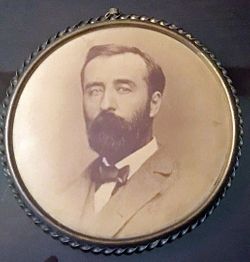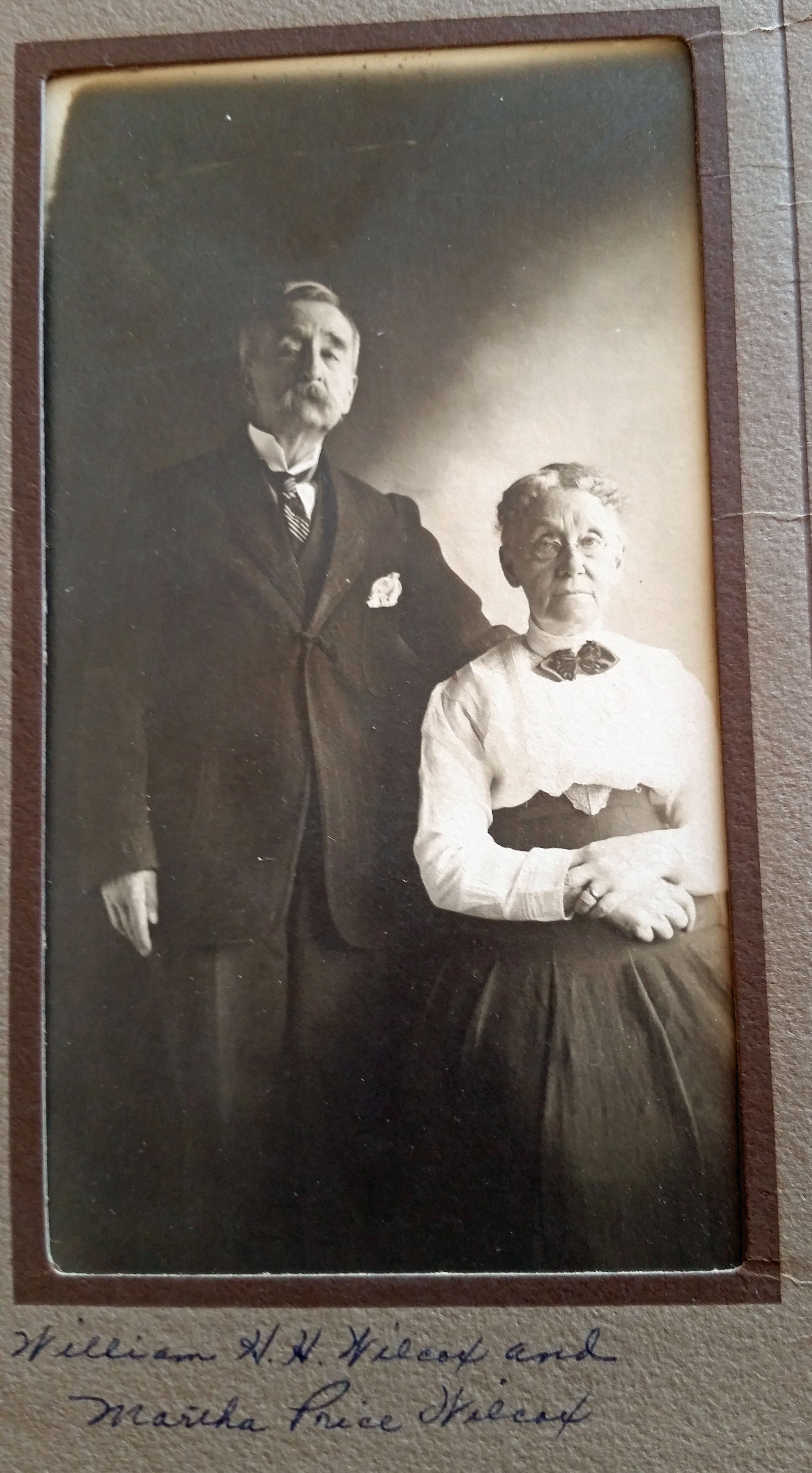William was born to Gertrude (Anna G.) Eacker and Lester Wilcox on Feb. 24, 1839 in Canajoharie, Montgomery County, NY.
On April 27, 1861, 22-year-old William H.H. Wilcox enlisted in the 10th New York Zouaves Infantry Division, Company A. He enlisted in New York City as a private. His military service records show that he was promoted to various ranks during his career. His final rank depends on which source you believe. A book on the Civil War, Escape from Libby Prison, says William was a 1st Lieutenant and Adjutant while service files say he was a 1st Lieutenant and Quarter Master Sgt. His obituary says he was a captain (promoted from 1st Lieutenant).
According to William's medical records, he was treated for a remittent fever and tonsillitis in August 1862. He was furloughed from Aug. 27 to Sept. 26 in 1862 and returned Sept. 26, 1862, returning to duty on Oct. 10, 1862. In April 1863, he suffered another fever before returning to duty.
He was captured at Elk Run, Virginia on October 13, 1863 and was taken to Libby Prison a Confederate prison for captured Union officers in Richmond, Va. Previously a tobacco warehouse,iIt consisted of three tenement (loft style) buildings, each 110x44 feet, 4 stories high. Living conditions were extremely bad: the food, sometimes lacking altogether, was poor and sanitation practically nonexistent. Thousands died there. Except for Andersonville Prison, Ga., Libby Prison was the most notorious in the Confederacy.
Many escapes occurred. The most spectacular escape was one led by Colonel Thomas E. Rose (77th Penna. Vols.) assisted by Major A.G. Hamilton (12th Kentucky) on February 9 1864, where 109 officers - including William H. H. Wilcox (listed in one account as Harry Wilcox)- tunneled their way out from the building under a vacant lot to the east. The only tools they had to use in the long tunnel digging were an old pocket knife, some chisels, a piece of rope, a rubber cloth and a wooden spittoon. They constructed the 53-foot-long tunnel, of which there are no remains, in 17 days. 59 were able to reach Union lines but 48 were recaptured and 2 drowned. Wilcox was among those soldiers re-captured, being caught just three days later on Feb 12 1864. Interestingly, various contemporary accounts list Wilcox as being a member of the 10th New York Cavalry (instead of the infantry). His military files all list him as a member of the infantry.
Wilcox was transferred to a prison in Macon, Ga. on May 7, 1864, and from there to a prison in Columbia, SC and he was paroled from Charleston, SC. on December 10 or 12, 1864 and mustered out by special order, February 21, 1865. His prison stay in October 1864 in Columbia, S.C. is blamed for his chronic rheumatism, according to his military pension records.
There were two prisons in Macon, Ga., Camp Oglethorpe and Smith Slave Mart operating at the time he was a prisoner of war. The conditions at Oglethorpe were described as being "by the summer of 1864, more than 2,300 Union officers were housed there. Shelter was barely adequate, and rations consisted of beans, corn meal, and rice in meager amounts. The lack of sanitation, coupled with a dwindling diet, led to the usual litany of such diseases as chronic dysentery and scurvy." (source: Mycivilwar.com). There were several prisons in Columbia, S.C.; based on the recorded operating dates, the likely candidates of his stay in Columbia are Camp Asylum/Camp Lunacy (the former state Lunatic Asylum) , Camp Sorghum (although if he was here, he would've been transferred because it was closed in Dec. 1864), the Florence Stockade. In Charleston, he could've been housed at Charleston County Jail, Charleston Guard House, Charleston Race Course.
Wilcox suffered from chronic rheumatism and heart disease after getting out of prison, and was deaf in his right ear. He lost all the toes on his left foot in a 1902 railroad accident at the Broad Street Station in Newark, NJ (can't find more details yet).
His married his first wife, Emily Clark, in Oct. 1868 and they had 5 children: Harry Lester, Herder Clark, Percy Chapel, Mary Gertrude and Edna Isabel. Mary and Edna died as infants. Emily died of tuberculosis in May 1878. Emily, Harry (who lived to 58), Mary and Edna are all buried together at Green-Wood. Herder hasn't been traced yet past 1900.
He married Martha Price on Oct. 5, 1880 in New York City. For forty-five years Wilcox served in the registry department of the New York Post Office, resigning in 1915 on account of ill health. He died in Newark, NJ on Sept. 6, 1916 of cardiovascular and renal disease.
He is buried with his second wife, Martha, at Fairmount Cemetery in Newark, NJ. His children, Mabel F. Colborn, Foster B. Wilcox and Jessie Garfield Wilcox are also buried there.
Wilcox's brothers, Herkimer E. and Albert E., and his grandmother, Gertrude Eacker, are buried in Palatine Bridge Cemetery in New York.
Through his mother, Anna Gertrude (Eacker) Wilcox, he is a great-grandson of Capt. George Herkimer (sometimes referred to as Colonel), who with his more famous brother, General Nicholas Herkimer , fought in the Revolutionary War.
He also was related to George I. Eacker, who shot Alexander Hamilton's son, Philip, in a duel. George I. Eacker was the brother of his grandfather Jacob I. Eacker. George is buried at St. Paul's Churchyard in Manhattan.
He also is descended from the Finck family , which included several Revolutionary War veterans. His great-great-grandfather was Andreas Finck who was believed to have served in the Revolutionary War and several of his sons and sons-in-law served, including his son, Major Andrew Finck Jr.
William was born to Gertrude (Anna G.) Eacker and Lester Wilcox on Feb. 24, 1839 in Canajoharie, Montgomery County, NY.
On April 27, 1861, 22-year-old William H.H. Wilcox enlisted in the 10th New York Zouaves Infantry Division, Company A. He enlisted in New York City as a private. His military service records show that he was promoted to various ranks during his career. His final rank depends on which source you believe. A book on the Civil War, Escape from Libby Prison, says William was a 1st Lieutenant and Adjutant while service files say he was a 1st Lieutenant and Quarter Master Sgt. His obituary says he was a captain (promoted from 1st Lieutenant).
According to William's medical records, he was treated for a remittent fever and tonsillitis in August 1862. He was furloughed from Aug. 27 to Sept. 26 in 1862 and returned Sept. 26, 1862, returning to duty on Oct. 10, 1862. In April 1863, he suffered another fever before returning to duty.
He was captured at Elk Run, Virginia on October 13, 1863 and was taken to Libby Prison a Confederate prison for captured Union officers in Richmond, Va. Previously a tobacco warehouse,iIt consisted of three tenement (loft style) buildings, each 110x44 feet, 4 stories high. Living conditions were extremely bad: the food, sometimes lacking altogether, was poor and sanitation practically nonexistent. Thousands died there. Except for Andersonville Prison, Ga., Libby Prison was the most notorious in the Confederacy.
Many escapes occurred. The most spectacular escape was one led by Colonel Thomas E. Rose (77th Penna. Vols.) assisted by Major A.G. Hamilton (12th Kentucky) on February 9 1864, where 109 officers - including William H. H. Wilcox (listed in one account as Harry Wilcox)- tunneled their way out from the building under a vacant lot to the east. The only tools they had to use in the long tunnel digging were an old pocket knife, some chisels, a piece of rope, a rubber cloth and a wooden spittoon. They constructed the 53-foot-long tunnel, of which there are no remains, in 17 days. 59 were able to reach Union lines but 48 were recaptured and 2 drowned. Wilcox was among those soldiers re-captured, being caught just three days later on Feb 12 1864. Interestingly, various contemporary accounts list Wilcox as being a member of the 10th New York Cavalry (instead of the infantry). His military files all list him as a member of the infantry.
Wilcox was transferred to a prison in Macon, Ga. on May 7, 1864, and from there to a prison in Columbia, SC and he was paroled from Charleston, SC. on December 10 or 12, 1864 and mustered out by special order, February 21, 1865. His prison stay in October 1864 in Columbia, S.C. is blamed for his chronic rheumatism, according to his military pension records.
There were two prisons in Macon, Ga., Camp Oglethorpe and Smith Slave Mart operating at the time he was a prisoner of war. The conditions at Oglethorpe were described as being "by the summer of 1864, more than 2,300 Union officers were housed there. Shelter was barely adequate, and rations consisted of beans, corn meal, and rice in meager amounts. The lack of sanitation, coupled with a dwindling diet, led to the usual litany of such diseases as chronic dysentery and scurvy." (source: Mycivilwar.com). There were several prisons in Columbia, S.C.; based on the recorded operating dates, the likely candidates of his stay in Columbia are Camp Asylum/Camp Lunacy (the former state Lunatic Asylum) , Camp Sorghum (although if he was here, he would've been transferred because it was closed in Dec. 1864), the Florence Stockade. In Charleston, he could've been housed at Charleston County Jail, Charleston Guard House, Charleston Race Course.
Wilcox suffered from chronic rheumatism and heart disease after getting out of prison, and was deaf in his right ear. He lost all the toes on his left foot in a 1902 railroad accident at the Broad Street Station in Newark, NJ (can't find more details yet).
His married his first wife, Emily Clark, in Oct. 1868 and they had 5 children: Harry Lester, Herder Clark, Percy Chapel, Mary Gertrude and Edna Isabel. Mary and Edna died as infants. Emily died of tuberculosis in May 1878. Emily, Harry (who lived to 58), Mary and Edna are all buried together at Green-Wood. Herder hasn't been traced yet past 1900.
He married Martha Price on Oct. 5, 1880 in New York City. For forty-five years Wilcox served in the registry department of the New York Post Office, resigning in 1915 on account of ill health. He died in Newark, NJ on Sept. 6, 1916 of cardiovascular and renal disease.
He is buried with his second wife, Martha, at Fairmount Cemetery in Newark, NJ. His children, Mabel F. Colborn, Foster B. Wilcox and Jessie Garfield Wilcox are also buried there.
Wilcox's brothers, Herkimer E. and Albert E., and his grandmother, Gertrude Eacker, are buried in Palatine Bridge Cemetery in New York.
Through his mother, Anna Gertrude (Eacker) Wilcox, he is a great-grandson of Capt. George Herkimer (sometimes referred to as Colonel), who with his more famous brother, General Nicholas Herkimer , fought in the Revolutionary War.
He also was related to George I. Eacker, who shot Alexander Hamilton's son, Philip, in a duel. George I. Eacker was the brother of his grandfather Jacob I. Eacker. George is buried at St. Paul's Churchyard in Manhattan.
He also is descended from the Finck family , which included several Revolutionary War veterans. His great-great-grandfather was Andreas Finck who was believed to have served in the Revolutionary War and several of his sons and sons-in-law served, including his son, Major Andrew Finck Jr.
Inscription
Capt. W.H.H. Wilcox, 10th NY N.Z.
Gravesite Details
First name is William. Husband of Martha Price Wilcox and father of Mabel F. Colborn, Jesse G. Wilcox & Foster B. Wilcox
Family Members
Sponsored by Ancestry
Advertisement
Advertisement





















